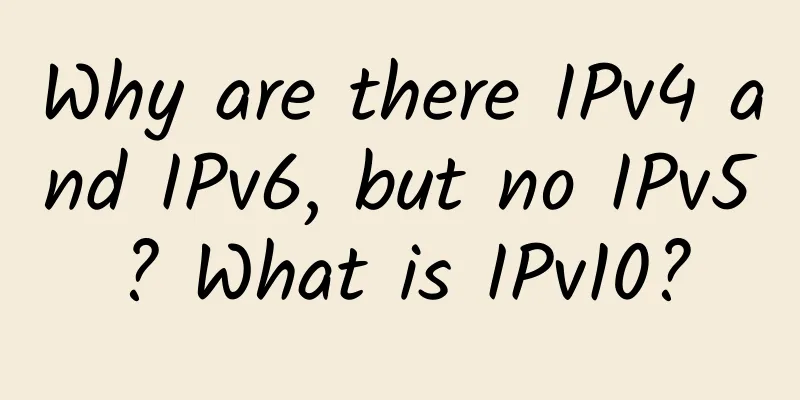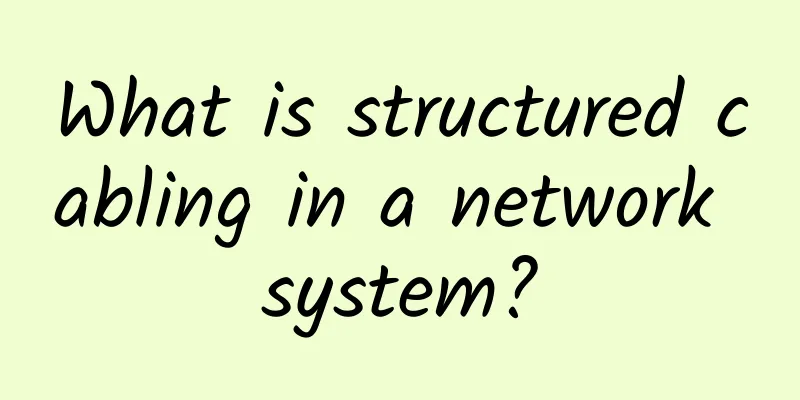Why are there IPv4 and IPv6, but no IPv5? What is IPv10?

|
As the country vigorously promotes the development of IPv6, IPv4 and IPv6 have gradually come into people's view. When we see these two brothers, we can't help but have some questions. Why is IPv4 directly IPv6? Where did IPv5 go? Since there is IPv6, will there also be IPv7, IPv8...?
In the long history of Internet development, IPv5 does exist. Not only that, IPv7, IPv8, IPv9, and IPv10 also exist. The birth of IPv5When IPv5 first appeared, it was called the Internet Stream Protocol and was created by Apple, NEXT, and Sun Microsystems to experiment with streaming voice and video. The characteristic of this protocol is that it can transmit data packets at a specific frequency while maintaining communication. IPv5 seemed like a good idea, but it was so similar to IPv4 that it was never accepted as an official Internet protocol. IPv5 has not really taken off, and is constrained by one key factor - it uses the same addressing system as IPv4. Like IPv4, each address is composed of four groups of numbers between 0 and 255, which means there are a total of about 4.3 billion addresses. As we all know, one of the main reasons why we have to abandon IPv4 is that the addresses provided by IPv4 are quite limited and cannot meet the needs brought about by the explosive growth of the Internet. In the past, perhaps only computers needed IP, but now perhaps televisions, refrigerators, washing machines, air conditioners and other devices all need IP. The addresses provided by IPv4 are far from enough. As early as 2011, all the IPv4 addresses in the world had been used up. The address length of IPv6 is 128 bits, which provides a total of 2 to the power of 128 addresses, and is said to be able to assign an address to every grain of sand in the world. Obviously, IPv6 is more in line with the development needs of the times. IPv5 is stuck in the middle, unable to go up or down, so it died in the experimental stage. IP Four Little DragonsIPv4 is the abbreviation of Internet Protocol version 4. Its full Chinese name is Internet Communication Protocol version 4. 4 represents the version number. IPv6 is the Internet Communication Protocol version 6. There are many versions of the Internet Communication Protocol, ranging from the first version to the tenth version. The transition from IPv1 to IPv3 only exists in the laboratory, with only theory but no implementation. Only IPv4 is the most mature and widely used. We have already talked about IPv5, and now we will talk about IPv6 to IPv9. Between 1994 and 1995, when the US IEIF was selecting the next-generation Internet standard, it had selected four options and later gave each of these four options protocol numbers. The IPv7 protocol number represents TP/IX technology, IPv8 is the PIP solution, IPv9 is the technical solution marked by TUBA, and IPv6 is also one of the solutions. Later, IPv6 won the competition. The three protocol numbers 7 to 9 still exist today, but unlike IPv6, IPv6 has a specific deployment plan and the status of a formal protocol, while the other three protocols are only experimental protocols. The Ultimate Solution - IPv10?Although IPv6 is much better than IPV4, they are incompatible with each other, which leads to many difficulties in migrating from IPv4 to IPv6. It is obviously impossible to completely replace IPv4, so experts have developed several solutions: (1) Dual protocol stack Let computers use IPv4 and IPv6 at the same time, and share IPv4 and IPv6. This solution will cause a problem. Hosts using IPv4 cannot communicate with hosts using the IPv6 protocol. When IPv4 addresses are exhausted, new Internet hosts will not be able to use IPv4 and IPv6 dual stacks. (2) Tunnel technology Before allowing hosts using the IPv6 protocol to communicate through IPv4-based hosts, the problem of communication between IPv4 hosts and IPv6 hosts has not been solved. (3) NAT-PT Allows hosts using the IPv6 protocol to communicate with hosts using the IPv4 protocol. This solution does not allow direct communication using IP addresses, and requires a large number of source and destination IP address conversions, so the efficiency is very low. The above three solutions all have some problems to varying degrees. Is there a perfect solution? Yes! It is IPv10! In 2017, the IETF released an IPv10 draft, claiming that this version of the Internet communication protocol allows IPv4 hosts to communicate with IPv6 hosts and vice versa. The IP datagram header of the IPv10 protocol contains IPv4 and IPv6 addresses, which allows hosts using two different protocols to communicate without the need for protocol conversion, and DNS is not required for address resolution during the communication process. Unfortunately, IPv10 is still just a draft, and no mainstream manufacturer currently supports IPv10. IP addresses are the cornerstone of the Internet, and their importance is self-evident. The upgrading of communication protocols has brought considerable challenges to mankind, and these difficulties may be completely resolved in the near future. It is also possible that IPv4 and IPv6 will continue to coexist. |
<<: 5 Reasons Why Process Industries Need Low-Power Wide Area Networks
Recommend
RackNerd US VPS starts at $9.89 per year, with multiple data centers in Los Angeles/Seattle, and supports Alipay
After more than three years of stable operation, ...
WiFi beginners guide: 4 things you need to know
Gone are the days of firing up our computers, plu...
Jiaxing Cloud Road: Tongxiang Smart Education and the 6 Major Projects Behind It
When the thousand-year-old ancient town Wuzhen wa...
Sharktech: $99/month-2*E5-2670V2/32GB/500G SSD/1Gbps unlimited traffic/Los Angeles high defense
Sharktech cancelled the lowest-priced $59/month L...
iWebFusion: US servers start at $49/month, high-end servers start at $219/month (Dual E5-2699v4/384G/1T NVMe/25TB)
iWebFusion (also known as iWFHosting) is a subsid...
Tencent Cloud Hong Kong Data Center Restocking, Lightweight Server/CVM Cloud Server Optional for New and Old Users
Last month, many friends who wanted to buy Tencen...
Why does TCP need three handshakes and four waves?
[[402116]] This article is reprinted from the WeC...
RackNerd Christmas promotion, Los Angeles KVM architecture 1.5G memory annual payment starts at $16.8
RackNerd is a foreign VPS hosting company founded...
RedCap Will 5G spark an IoT gold rush?
A scaled-down version of 5G could spark a surge i...
What exactly is 5G Open RAN?
Traditionally, the proprietary network equipment ...
V.PS: €5.95/month KVM-1GB/20GB/1TB/12 data centers available in the United States, Japan, Hong Kong, etc.
V.PS is a site under xTOM (founded in 2012). V.PS...
Apple Pay enters China: Alipay and WeChat face off
[[180184]] ApplePay On February 18, Apple Pay off...
80% of users face challenges in PoE deployment
Four out of five users experience challenges when...
Wu Jingtao returns to F5 as new CTO to explain F5's future direction
[51CTO.com original article] Wu Jingtao is the ki...
Maxthon Hosting: Los Angeles Unicom CU2 VIP Line VPS monthly payment starting from 38 yuan, Hong Kong CN2 high-defense available
Let's continue to share information about Max...









